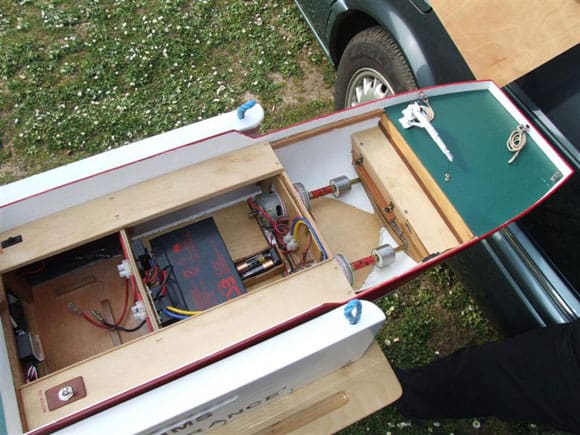
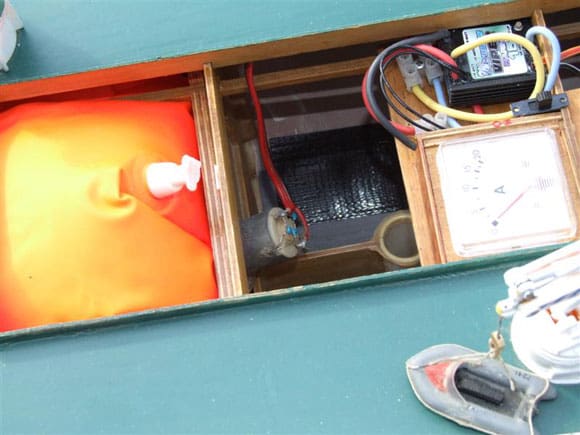
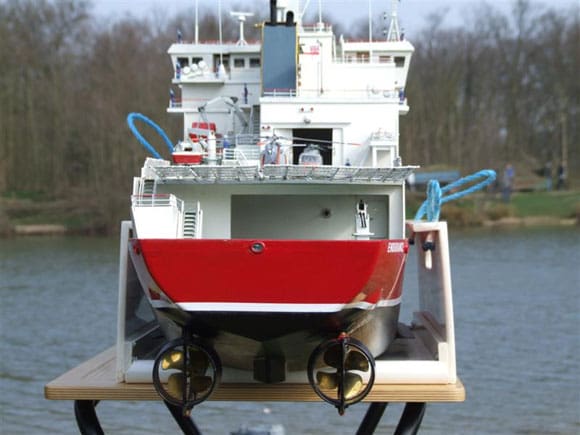
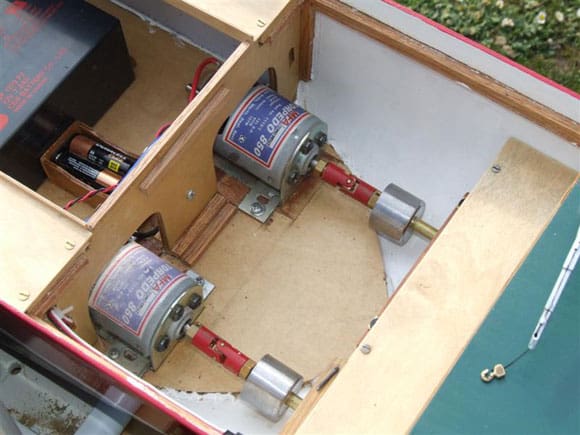
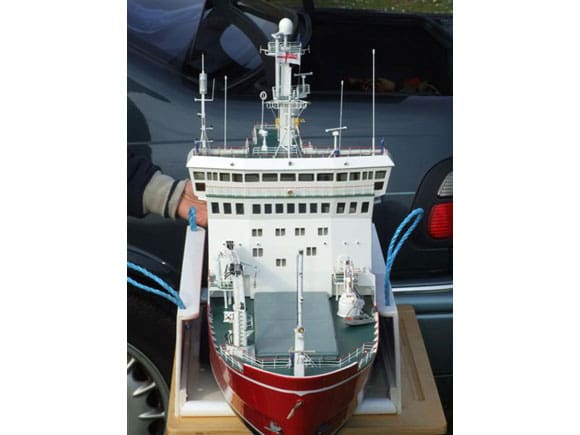
HMS Endurance
I had a telephone call from a mutual friend, Bob Powis, around the end of March, who asked if I was interested in taking photographs of John Mansfield’s model of HMS Endurance. I contacted John who gave some brief details of the model and we arranged to meet at the Grays Thurrock Model Boat Club’s water at Belhus Park in Essex (this is an excellent facility in pleasant surroundings – editor).
On the due date, the weather was bright and sunny, but there was quite a breeze and knowing that the Endurance has quite a substantial superstructure, I began to wonder if the maiden voyage would take place. John arrived with the hull of the model on the back seat of his car and the superstructure in the boot. After the usual pleasantries, I asked John about the model at which point he thrust three pages of notes into my hand, which saved me from writer’s cramp!
The build had begun sometime before, when John had been given a Graupner Seabex hull plus a variety of warped timber. This created a problem, in that the Seabex could be built, but there were no plans available and the timber parts were beyond restoration. So John sought something suitable to build using the Seabex hull. Browsing the Internet, he came across the Royal Navy site complete with photos of the Endurance. This was it – copies of the photos were printed and the dimensions of the full-size hull were compared to the Seabex hull. This gave a scale of 1:72, which would be the conversion rate used for the build.
Enjoy more Model Boats Magazine reading in the monthly magazine.
Click here to subscribe & save.
A plan was drawn, by scaling the dimensions of the photos, which gave a workable solution for the superstructure etc. The next step was to tackle the hull. A short foredeck was added to the Graupner hull to match the full size vessel. The hull area was divided by the addition of 6mm ply bulkheads, after determining the positions of the drive motors and batteries etc. 4mm ply was used between the middle three bulkheads to support the two 12Volt batteries. These can be seen in photo 1. The floors were stuck in place with two-part epoxy adhesive and then treated with satin yacht varnish. Stringers were made up of 4mm square mahogany to support the main deck. To match the hull profile of the full size vessel, the rear of the hull was cut down. This can also be seen in photo 1. A Graupner bow thruster was fitted, the motor of which can just be seen in photo 2. The bow thruster cross tubes were drilled to take 2mm brass rod to act as a grill to prevent the ingress of weed. The bow thruster assembly was glued in place with two-part epoxy adhesive.
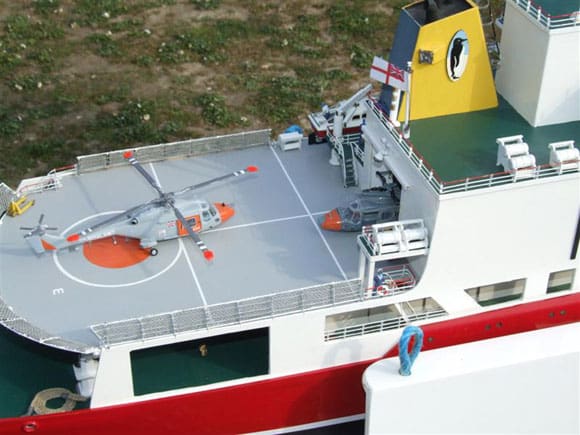
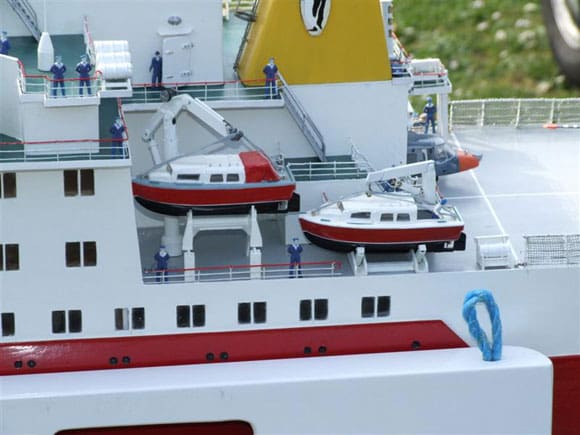
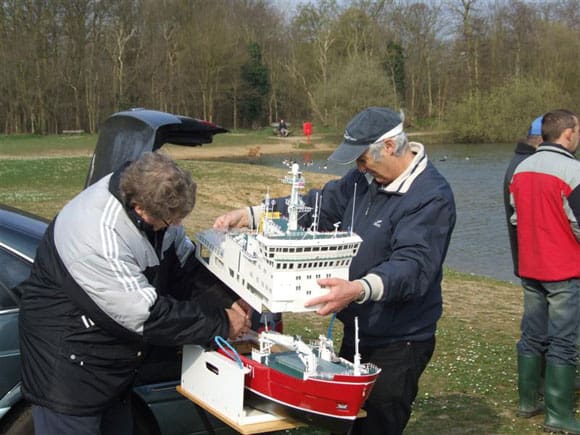
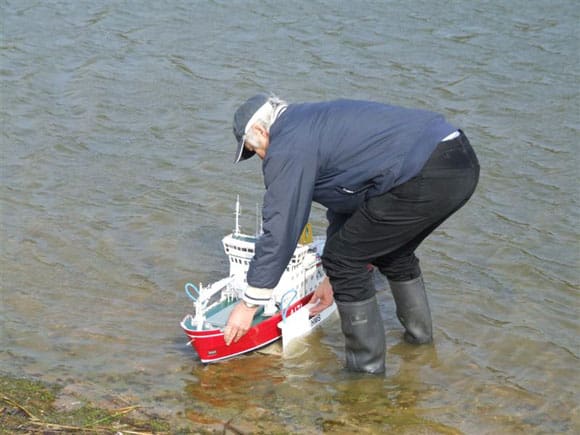
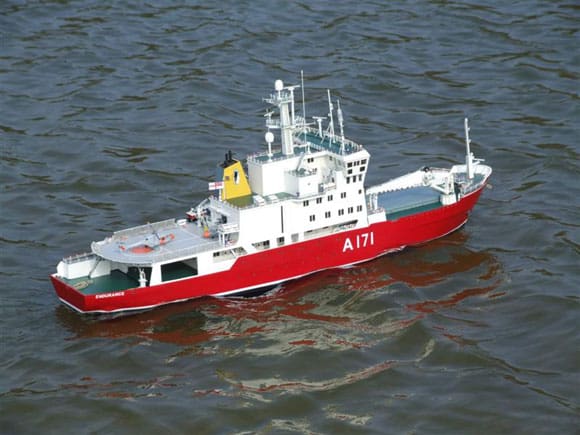
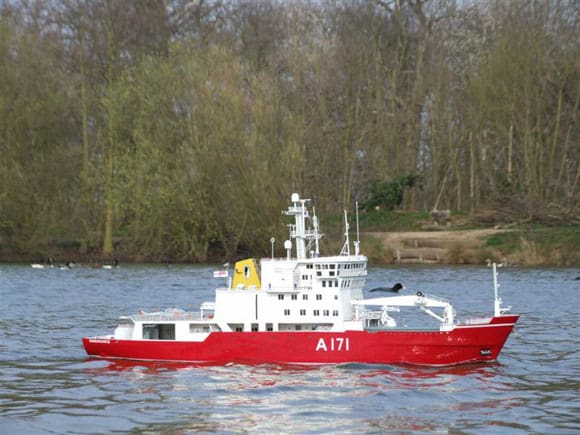
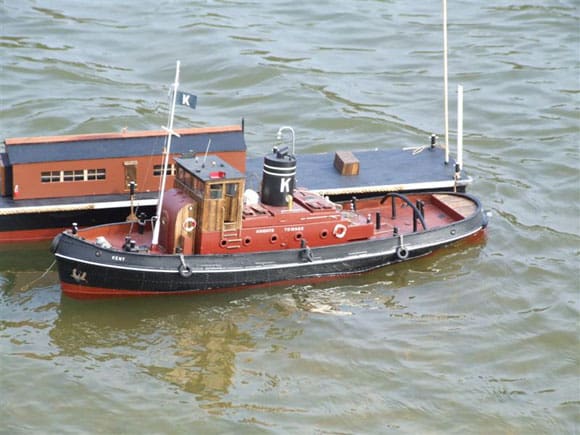
Two Kort nozzles were purchased from the Dockyard Model shop at Chatham. These were duly installed and glued into place with two-part epoxy adhesive. After these had set, the two nine inch propeller shafts were fitted. These were aligned to the nozzles by making two plastic card discs to fit into the nozzles and they were temporarily secured to the shaft. The shaft angle was dictated by the drive motors, which were to be two MFA Torpedo 850’s. Photo 3 shows the Kort nozzles with the Raboesch four bladed propellers. Propellers and shafts came from ‘Modellers World’. Photo 4 shows the twin 850 drive motor installation.
John’s next task was to build the superstructure. This was built from the photographs mentioned earlier. John was quite happy with this as the model was to be ‘Stand-Off’ scale rather than ‘Exact’. 3mm ply was used for the main superstructure up to the bridge, which was to be built later. After the window apertures had been marked and cut out, the two superstructure halves were fitted onto the hull and adjusted to the correct width. The main superstructure was angled when viewed from above, as well as from the sides. This can be clearly seen in photo 5, of the upper bridge. This front part was made separately on a former and after the windows had been cut out, it was then fitted into place between the superstructure sides. The heli-deck was made from 4mm ply, photo 6 and this added to the superstructure strength.
The upper bridge was fabricated from 1.5mm ply as a separate assembly and then added. The roof of the upper bridge was temporarily screwed in place to allow for the addition of detail inside the bridge later. The mainmast, which can be seen in photo 5, is made from plastic card. The platforms on the mast were from 2mm ply and a Model Motors Direct radar motor with two pulleys for the two radar scanners was also fitted. A further motor has yet to be added, as well as a sound unit and lighting. Additional detail was now added, the two small ship’s boats, photo 7 being purchased from Scoonie’s Hobbies. The mesh guardrails around the helicopter deck, photo 6 can be lowered by hand. It is John’s intention, to link this to the actuation of the helicopter’s rotor at a later stage.
After completing the painting of the model John carried out a water test and as a result added bilge keels to the model to improve stability. So, back to the lakeside. Photo 8 shows John (on the right) being helped by Bob to fit the superstructure to the hull. The model sits on its stand that also doubles as a launching cradle, with handgrips each side, photo 9. After floating off the cradle, John took the model away from the shore. Photo 10 gives some idea of the action of the wind on the water at the lake – it was quite choppy. As this was the maiden voyage it went remarkably well, with the exception of some reversals of transmitter functions! John has really made a first class job of this – if it wasn’t for the moorhen in the background to spoil the illusion, it really looks the part, photo 11. Thanks for the invite!
While at the lakeside, I took the opportunity to chat to some of the other Grays Thurrock Model Boat Club members. A couple of them were also having a sail despite the breezy conditions. Alan Tomlinson was sailing his model of the Kent, photo 12. This is also scratch built on a pre-made (fibreglass) hull. The vessel is driven by a MFA 800 motor with an Electronize ESC. Radio used is a Futaba receiver with a Hitec transmitter. A 12v 12amp SLA (Sealed lead Acid) battery provides the power. Alan had also brought along his floating dock for the Kent to berth alongside, photo 13.
Derek Marston was sailing his Brave Borderer which he had based on the Perkasa kit, photo 14. A MFA 850 motor drove this. Derek is using a Sea Hunter ESC and Futaba 2 channel radio. Two 6v SLA batteries provide the power. Derek describes his model as ‘very reliable’. Can’t ask for much more than that can you? Well, that concluded my visit to Grays Thurrock Model Boat Club and the maiden voyage of John’s HMS Endurance. Thanks to all.
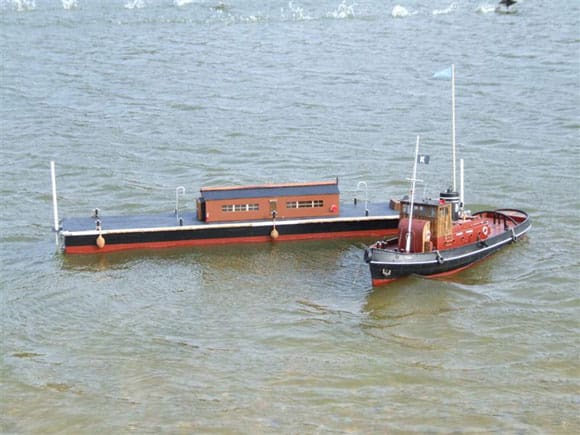
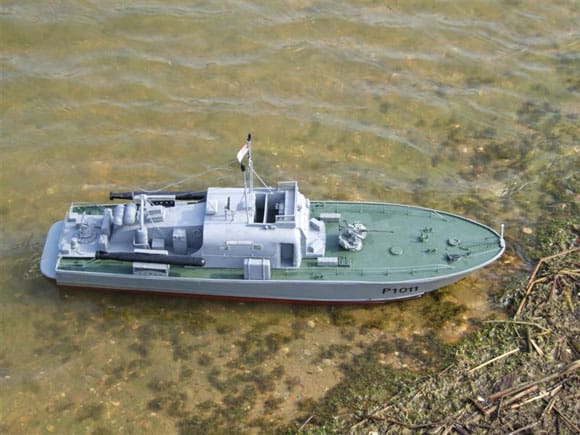
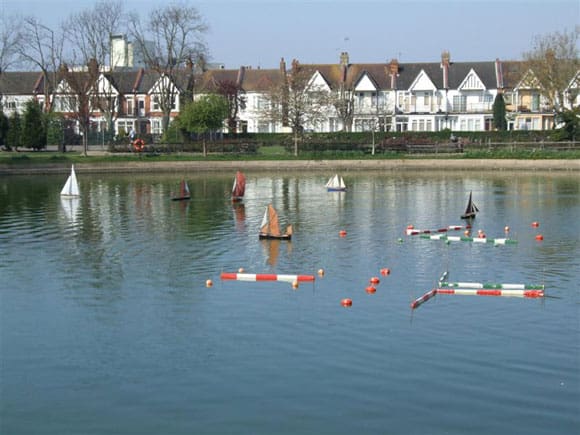
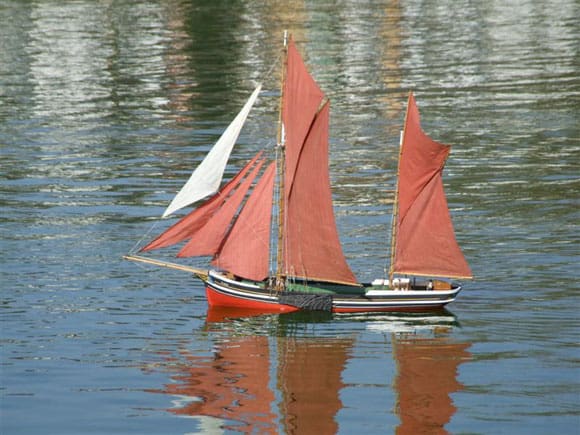
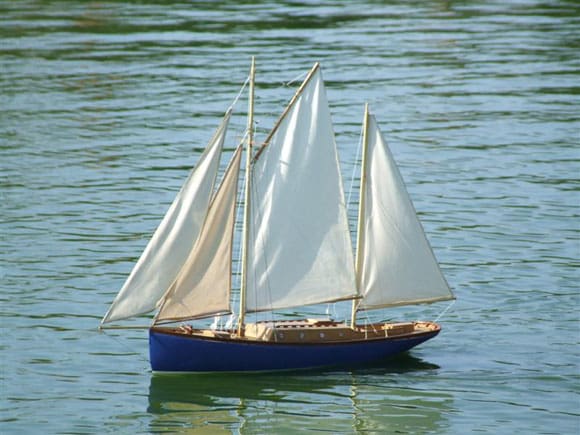
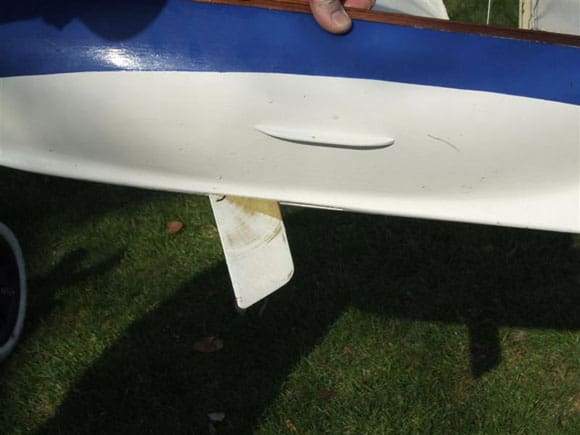
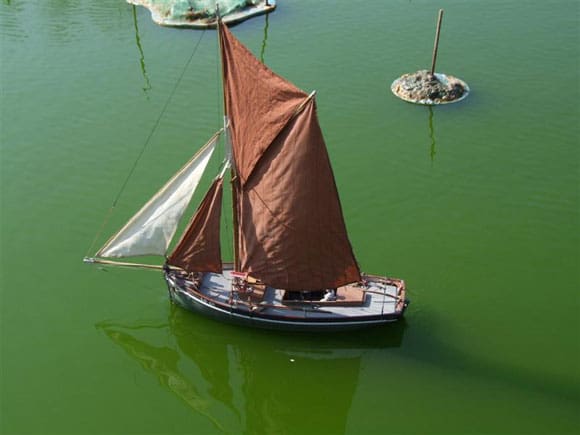
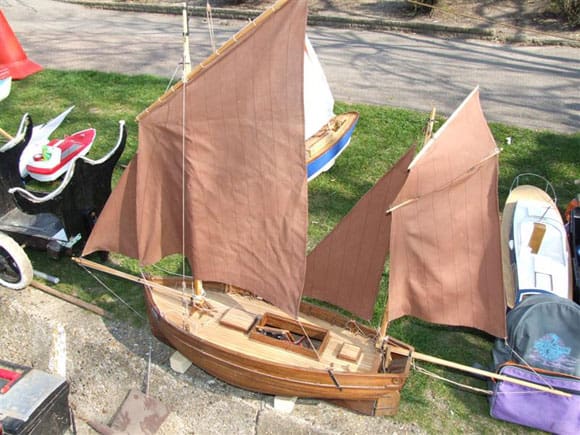
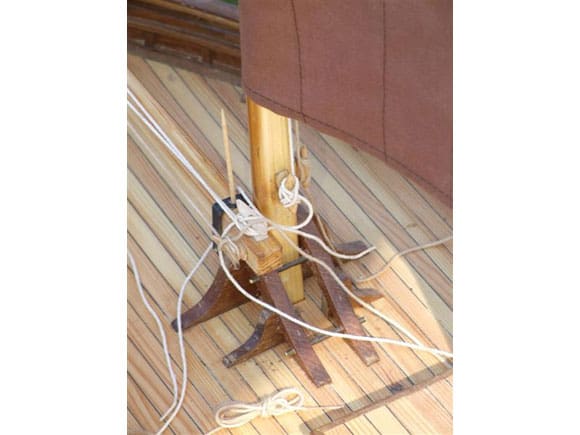
Spring Open Fun Day
Our next venture was in mid April, when we made the trip to Southend for the Southend MBC ‘Spring Open Fun Day’. The first impression that we got was the number of scale sailing vessels making use of the lake in Southchurch Park. Incidentally, if you plan to visit in the summer months, get there early, as parking near the lake entrance can be difficult. Having said that, you may drive into the park for the purpose of unloading and loading your models, so it’s not all bad news! Photo 15 shows the scale sailors in action and in the foreground is part of the scale steering course laid out for anyone to use if they so wished. This was strictly a fun day, no competitions, with the exception of the fast electric boats. There were quite a selection of scale sail models, including several Thames Barges, a Boomie and a couple of Luggers. Photo 16 is of Bob Potter’s Boomie Pearl. After expressing my ignorance, I was told that a ‘Boomie’ is a ketch-rigged barge. Les Fuller built this pretty little ketch, photo 17. It is based on a design by Maurice Griffiths, Yacht Designer and Sailor. It has a drop keel centerboard, photo 18. Les was also sailing his model called Inshore Trader, photo 19.
As well as his Boomie, Bob Potter had brought along his Hasting Lugger, Sussex Maid (1750). Bob had based his model on a painting and a pen and ink drawing found in a book, photo 20. A retired gentleman, and obviously used to working with wood, Bob built the hull, clinker built plank on frame, in three weeks. Built from teak, each plank is rebated to fit more closely to its neighbour. When satisfied with the fit, Bob glues each plank in place with superglue. The inside of the completed hull is then treated with a coating of epoxy resin. The deck is from pine, photo 21, and the model has the distinctive double stern, photo 22. The original was designed to prevent the boat from being pooped, when launched stern–first from the beach. This lugger, photo 23, is owned and sailed by Bill Windmill. Gerry Towner, club secretary, was demonstrating his impartiality, by sailing his Thames Barge, photo 24, followed by an outing with his Huntsman, photo 25. Back around the year 2000, both Gerry and I were at a model boat event when these were being sold off as shop returned stock. Mine is still in the loft! So much to do and so little time! There were several visitors from other clubs present. Ken and Jean Davy from our own club, Brentwood put in an appearance and as usual Ken said, ‘I haven’t anything ready’ and ended up being allowed to sail Jean’s Canal Boat ‘Woody’ which is based on the George Turner model, photo 26.
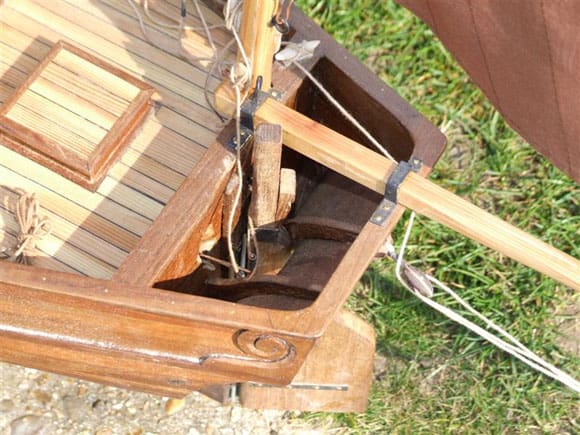
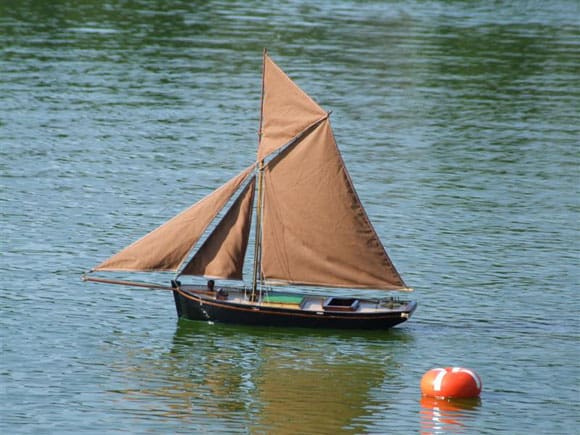
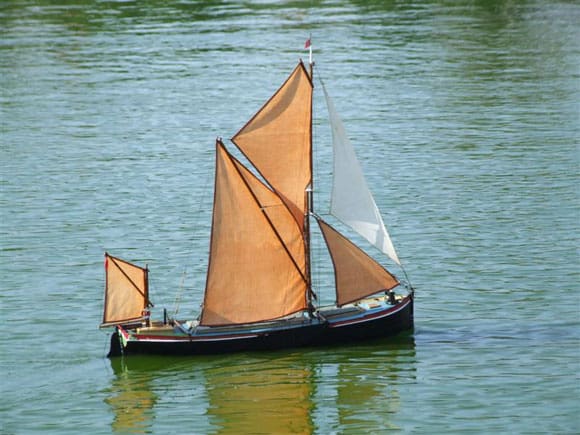
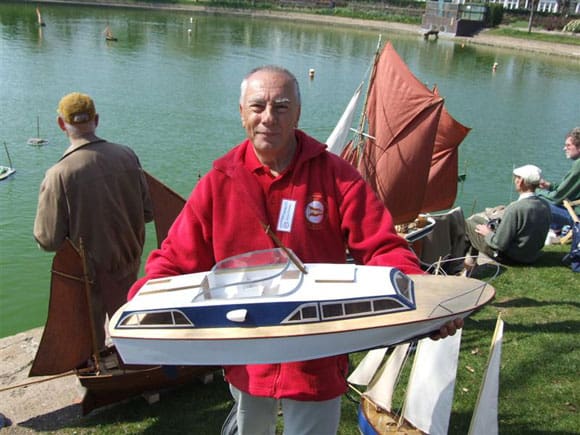
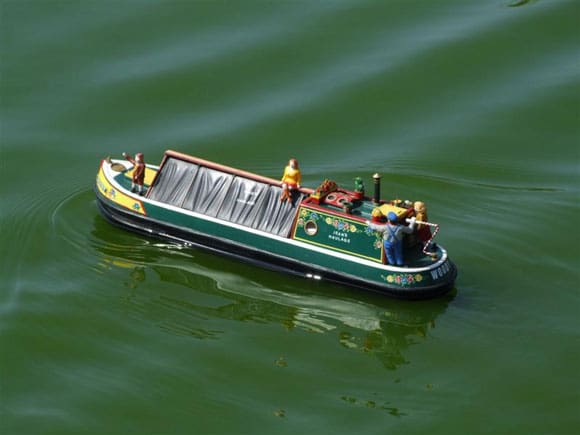
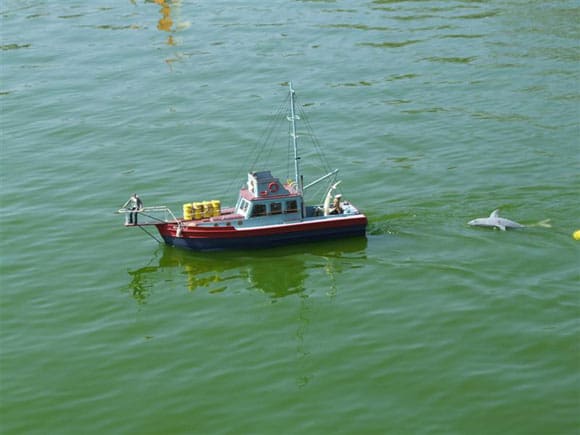
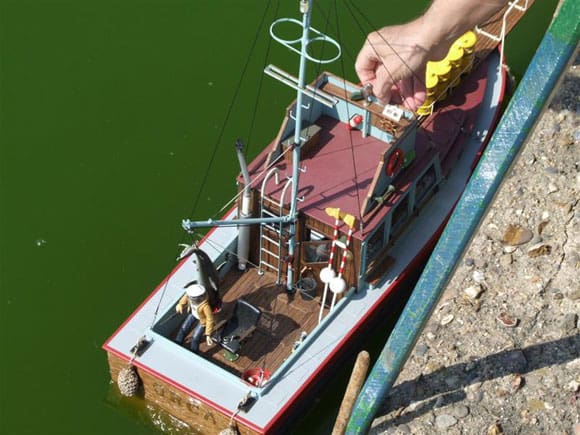
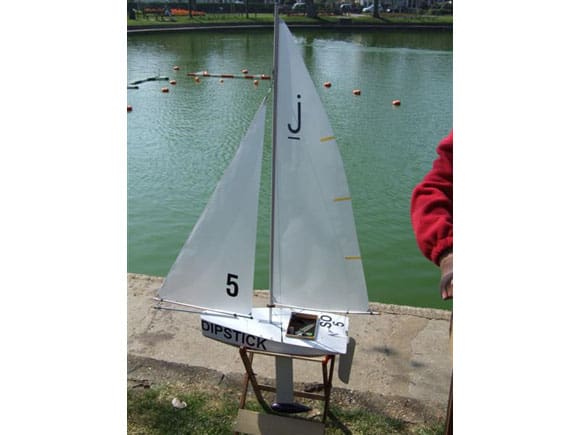
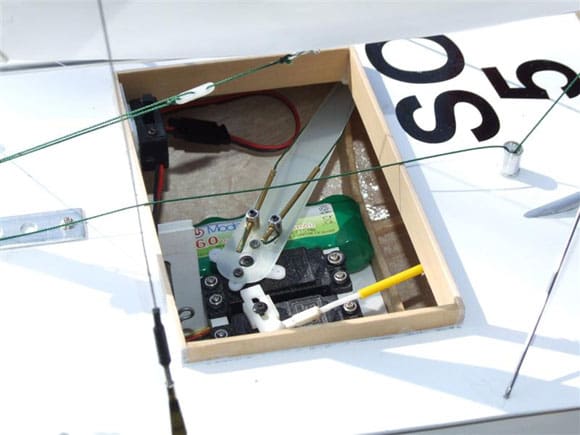
Terry Stagg, a member of the Northampton Model Boat Club, had also made the journey to Southend. Tony was sailing his model of the ‘Orca’ from the film ‘Jaws’. Tony said that his scratch built model was built from images taken from the film resulting in constant stop/pause/start on the video recorder! The model, photo 27, has a ply hull and superstructure, with the rest of the bits and pieces built from plastic styrene card. Terry is using Futaba radio, four 7.2v NiCad packs, a 550 type motor and a Turbocat diesel sound effect from JJC Electronics. The model also has seagull and horn effects. Tony has really gone for the authentic touch with tins of beer, plates of paella and bottles of drink in the cabin. Close inspection of the after well, will show the bucket of offal used to entice the shark! Photo 28 shows how successful that has been.
Finally from Southend was this unusual yacht, photo 29. Not really ‘scale’ but this is a French design called ‘Jauginette’ and this model was built by Dave Hallam from the host club. Graham Fright, also from that club has built one from frames downloaded from the web Here. Click ‘translate this page’ to put it into English! The frames are 1/8ins balsawood together with 1/4ins balsawood stringers. The hull is skinned with 0.8mm ply. The sails are from drawing film, the mast and booms by B & Q (the cathedral of DIY), and bits and pieces came from Housemartin Sails. Photo 30 is of the interior layout and standard servos are used.
Well that’s all from me this month. I’m just about to get packed for the modeller’s week at Skipsea, so I’ll bring you up to date about that next time.
If you want to get in touch, please e-mail [email protected], or contact me via the editor, please.




